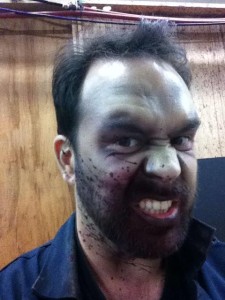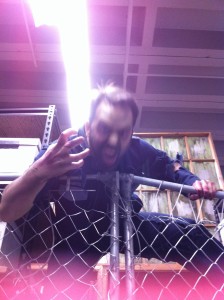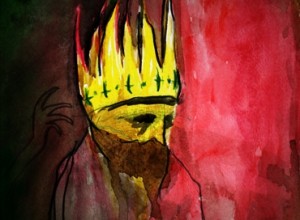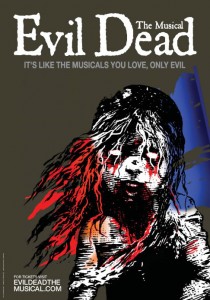 Dr. Dre thrummed along in the background while I was being turned into a dead cop. The makeup artist told me to close my eyes while she worked, spraying paint of various colors on my face. The decades-old beats of The Chronic played away, and I refrained from bobbing my head. “Hold still,” said the makeup artist, “I’m going to splash blood on you.” I held still. She splashed blood on me. It tickled.
Dr. Dre thrummed along in the background while I was being turned into a dead cop. The makeup artist told me to close my eyes while she worked, spraying paint of various colors on my face. The decades-old beats of The Chronic played away, and I refrained from bobbing my head. “Hold still,” said the makeup artist, “I’m going to splash blood on you.” I held still. She splashed blood on me. It tickled.
Last Friday evening I spent much of my afternoon and all of my evening at FrightTown, one of the largest haunted houses in Portland. A few of my friends had volunteered as monsters previously, had said it was fun, and convinced me to come out.
Based on my height, my looks, and the casting guy’s three second appraisal of my general demeanor, I was put in the role of Evidence Locker Zombie. “It’s high energy,” said the guy, “you think you can handle that?” I said that I could. He gave me a card and told me to report to the costume and makeup people. I was given a torn-up jumpsuit that said “POLICE” on the chest, and sat down to get turned into a blood-splattered corpse.
I was initially a little disappointed at being made a zombie. They’re pretty-much played out in popular culture. I’d hoped that FrightTown would make me a werewolf, what with being all hirsute and such. However, there were no werewolf roles. I decided, though, that I’d make the most of being a walking corpse. Zombies are solid, respectable horror antagonists, and at least I hadn’t been cast as a killer clown.
When I stepped out of makeup I was surrounded by a plethora of bizarre figures. Cultists. Fish people. A guy with a chicken for a head. A guy with a cooked chicken for a head. More zombies. A gigantic fat man with no shirt and gigantic shoulder armor. Killer clowns. A go-go dancer all of whose skin was green. Evil Santa. It was kind of like the Star Wars cantina, except an entirely different genre and no one was drinking.
I and my fellow zombies were given a brief acting lesson (we weren’t allowed to talk, for instance) and led into the playwood-and-props maze that was to be our haunt, a zombie apocalypse inspired by 28 Days Later, Resident Evil, and The Walking Dead. (FrightTown is actually three different haunted houses. There was also a Lovecraftian villiage and a haunted funhouse.) The sets were painted to look like desolate streets, bloody hospitals, and sinister decontamination chambers. As a zombie cop, I was to hang out in the destroyed police station, specifically in the evidence locker. It was, I think, the most physical job in the entire haunt.
The evidence locker contained several metal shelves behind a cyclone fence. The fence and shelves were bolted together in such a way that they were stable, and the zombie within could climb up and scare the passers-by. The following photo is of poor quality (and there was obviously much different lighting while the haunt was in full effect) but it gives you an idea of how I appeared to most people going through FrightTown.

When the fluorescent lights went off and the music and sound effects started up, I paced nervously in my abandoned, post-apocalyptic police station. I was wondering if I’d actually be able to scare people, or if the public would find any of the sets and costumes at all convincing. As people came in, though, my worries died away.
The first people I saw were a teenage couple clutching each other tightly as they ran past my evidence locker. I didn’t even get a chance to jump out and scare them. As other people moved in, I got into a groove. I’d hide behind the metal shelves and wait for them to look into the evidence locker, wondering where the zombie was. I’d jump out, scare them, snarl, and then climb the shelves and fence like I meant to pursue them. Sometimes I hung out on top of the fence, draped over it like a dead-looking dummy and then went “RAWR!” as they looked up. If there were a lot of people passing through the room at once, I’d gnash and yell and scream from my perch. My habit of towering above the customers while screaming and rattling the fence got me nicknamed “King Kong” by the event management. I was fine with that.
It was effective. There were some people, mostly young men, who acted too cool for the haunted house, but for the most part folks seemed to appreciate the show I was putting on for them. The most rewarding bit of my night was when a woman, after I jumped out, said “you’re behind a fence, you can’t get us.” I locked eyes with her, screamed in her face, and began climbing and yelling. A very loud “WHAT THE FUCK” left her mouth, and I was satisfied with a scare well done. Many other people seemed disquieted by my performance. “You can’t climb,” they said, “zombies aren’t allowed to climb.” But I did. I climbed up the fence like I was coming for them, and they ran away to the next room of horrors, a cadaver-strewn jungle populated by undead soldiers.
Kids were numerous and scared easily. To tell the truth, scaring kids almost felt like cheating. I got no end of amusement, though, at seeing the smiles on adults as their children screamed their heads off. Large groups of adolescents and twentysomethings came in, almost always clutching each other. One person would have their hands on the shoulders or about the waist of their friend in front of them, holding themselves against the monsters. The haunted house veterans called this formation a conga line, and I wondered how many people were using the scariness of the haunted house as an excuse to cop a feel. Probably a lot.
My gig as the evidence locker zombie is the most physically demanding thing I’ve done in a while. Constantly climbing up and down a thing, jumping, yelling, and generally being a rage zombie from 7:00 until 11:30 is, it turns out, fairly tiring. I also blew out my voice out from all the screaming and growling and I sounded sort of like Christian Bale’s Batman for the next 48 hours. My arms were cut up and bruised from places I’d hit myself on the fence, and my whole body was sore.
It was all worth it, though. As a lover of horror and someone who enjoys being freaked out and scared it was great to help create the sense of dread. I have no idea how many zombie movies I’ve watched or video games I’ve played. As much as I’m tired of them now (and I do think they’ll come back around) it was a wonderful feeling to finally be the thing I enjoyed, not just consume it. As I yelled and growled and pretended to hunger for flesh I felt more connected to the genre than every before. It wasn’t something I was watching or playing or reading. It was something I was embodying. Getting dressed up as a walking corpse was a fantastic reminder of how great it feels to imagine, to put on a show, and to create.



